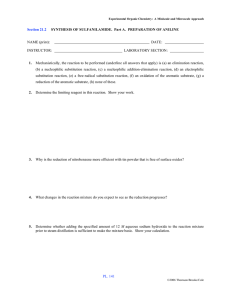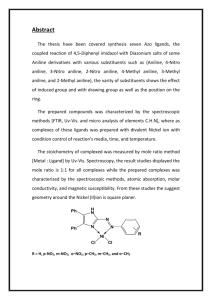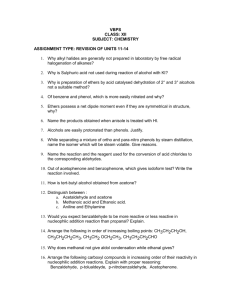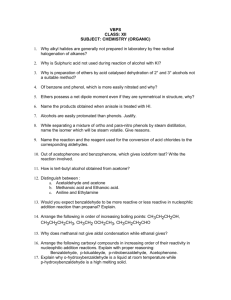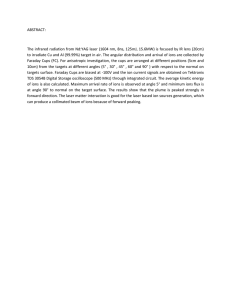Reaction dynamics of aniline-ammonia cluster ions in intense laser fields by
advertisement
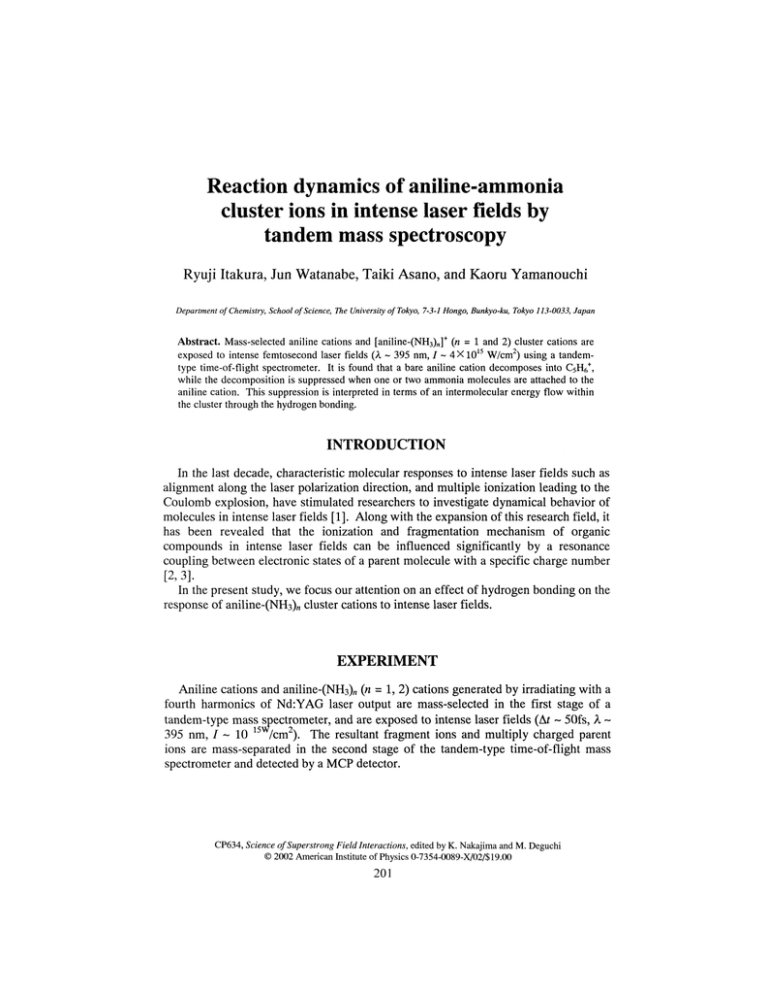
Reaction dynamics of aniline-ammonia cluster ions in intense laser fields by tandem mass spectroscopy Ryuji Itakura, Jun Watanabe, Taiki Asano, and Kaoru Yamanouchi Department of Chemistry, School of Science, The University of Tokyo, 7-3-1 Hongo, Bunkyo-ku, Tokyo 113-0033, Japan Abstract. Mass-selected aniline cations and [aniline^NHs),,]* (n = 1 and 2) cluster cations are exposed to intense femtosecond laser fields (A ~ 395 nm, / ~ 4 X1015 W/cm2) using a tandemtype time-of-flight spectrometer. It is found that a bare aniline cation decomposes into C5H6+, while the decomposition is suppressed when one or two ammonia molecules are attached to the aniline cation. This suppression is interpreted in terms of an intermolecular energy flow within the cluster through the hydrogen bonding. INTRODUCTION In the last decade, characteristic molecular responses to intense laser fields such as alignment along the laser polarization direction, and multiple ionization leading to the Coulomb explosion, have stimulated researchers to investigate dynamical behavior of molecules in intense laser fields [1]. Along with the expansion of this research field, it has been revealed that the ionization and fragmentation mechanism of organic compounds in intense laser fields can be influenced significantly by a resonance coupling between electronic states of a parent molecule with a specific charge number [2, 3]. In the present study, we focus our attention on an effect of hydrogen bonding on the response of aniline-(NH3)w cluster cations to intense laser fields. EXPERIMENT Aniline cations and aniline-(NH3)w (n = 1, 2) cations generated by irradiating with a fourth harmonics of Nd:YAG laser output are mass-selected in the first stage of a tandem-type mass spectrometer, and are exposed to intense laser fields (Af - 50fs, A ~ 395 nm, / - 10 /cm2). The resultant fragment ions and multiply charged parent ions are mass-separated in the second stage of the tandem-type time-of-flight mass spectrometer and detected by a MCP detector. CP634, Science of Superstrong Field Inter actions, edited by K. Nakajima and M. Deguchi © 2002 American Institute of Physics 0-7354-0089-X/02/$ 19.00 201 RESULTS AND DISCUSSION It was found that a small portion of aniline cations in intense laser fields (A ~ 395 nm) undergoes the decomposition into CsH6+ and HNC. This fragmentation is considered to occur through a resonant coupling between the electronically excited 2Bi and ground 2Bi states. When hydrogen bonded [aniline-(NH3)w]+ (n = 1, 2) cluster ions are exposed to the intense laser fields, the decomposition of the aniline cation moiety is significantly suppressed, and instead the evaporation of NHs proceeds. As shown in table 1, the yields of Csli6+ from the [aniline-(NH3)n]+ (n = 1, 2) cluster ions with respect to the corresponding parent ions are only 0.56(1) X10"3 and 2.2(2) XlO" 3 , respectively, which are 11 and 44 % of the corresponding ratio, 5.2(3) X 10~3, for the bare aniline cations. The formation of C^H^ from the planar aniline cation is expected to proceed through a transition state in which the geometrical structure around the amino group is substantially deformed, since one of the two H atoms in the amino group needs to migrate into the ortho-carbon site by simultaneously carrying a positive charge. The suppression of decomposition of an aniline moiety in the cluster cations indicates that the NHs attachment to the amino group hinders largely the migration of H atom in the amino group. TABLE 1. Relative yields of C5H6+ with respect to the signal _______intensities of parent ions.______________ _____Parent ions_____________Relative yields aniline cation 5.2(3) X 10"3 + [aniline-(NH3)] 0.56(1) X 10'3 ______[aniline-(NH3)2r___________2.2(2) X 1Q'3 In view of the infra-cluster energy flow, it is possible that a part of the energy gained from the photon fields is distributed to the NKb moiety through the intermolecular hydrogen bonding, and eventually, its small portion is consumed for the breaking of one or two intermolecular hydrogen bonds. Such an energy flow may lower the energy kept in the aniline cation moiety below the threshold energy for its decomposition. REFERENCES 1. Yamanouchi, K., Science 295, 1659 (2002). 2. Itakura, R., Watanabe, J., Hishikawa, A., and Yamanouchi, K., J. Chem. Phys. 114, 5598 (2001). 3. Watanabe, J., Itakura, R., Hishikawa, A., and Yamanouchi, K., J. Chem. Phys. 116, 9697 (2002). 202
